The Turboprop World-Beater VISCOUNT
Gerry Sweet chronicles the history and development of the UK's
most successful propeller-driven
commercial airliner.
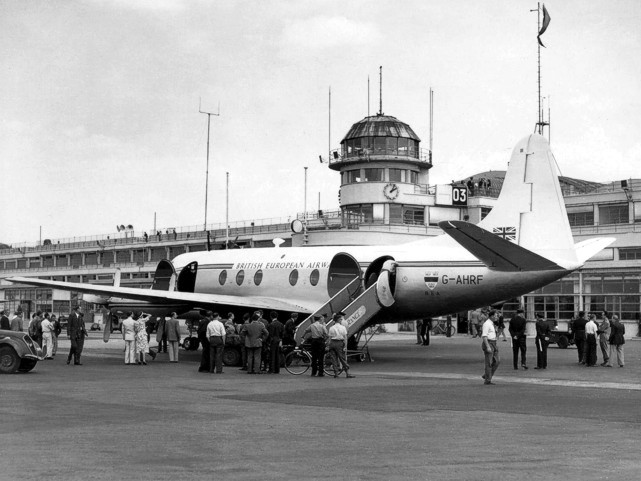
BEA - British European Airways V.630, G-AHRF, c/n 1. This aircraft performed the airline's,
and the type's,
first turboprop passenger flight, to Paris from London/Northolt, in July 1950
The Vickers Viscount, which made its maiden flight 60 years ago on Friday, 16 July 1948, was the first turboprop
airliner to operate a passenger service, and one of the few British types to achieve significant sales in North
America. The type's success was largely attributable to its reliable Rolls-Royce turboprop engines, which were
able to provide more power for the larger versions of the aircraft as they evolved. It was one of Britain’s most
successful post war civil aircraft, its sales exceeded only by the smaller de Havilland Dove.
Background
The Viscount, or Vickers VC2 project, as it was initially called by the company, was mooted by the company's
chief designer, Rex Pierson, in December 1944 during discussions with the Brabazon committee, which had been
formed the previous year to investigate the future needs of the British civilian airliner market. The VC2 was
proposed as a second generation airliner; later ratified in the Committee’s Type IIB specification, which
described a short to medium-range transport, powered by the then emerging turboprop engine. The Brabazon Type
IIA specification referred to a similar, piston-engine type, which eventually emerged as the Airspeed Ambassador.
The proposed design, which Pierson submitted to the Ministry of Aircraft Production (MAP) in 1945, was for a
four-engine, 27-seater with a gross weight of some 34,000lbs (15,455kgs), a still air range of 1,000 miles
(1,612km) and a cruising speed of about 300mph (484km/hr) at 20,000ft (6,154m). MAP accepted this proposal with
the additional requirement that the fuselage should be pressurised. Pierson’s original concept was for a double
bubble fuselage design, but when George Edwards (later Sir George) was promoted to chief designer that
September he decided against this, in favour of a single, circular fuselage with an increased capacity for 32
seats. A nose wheel undercarriage was also incorporated.
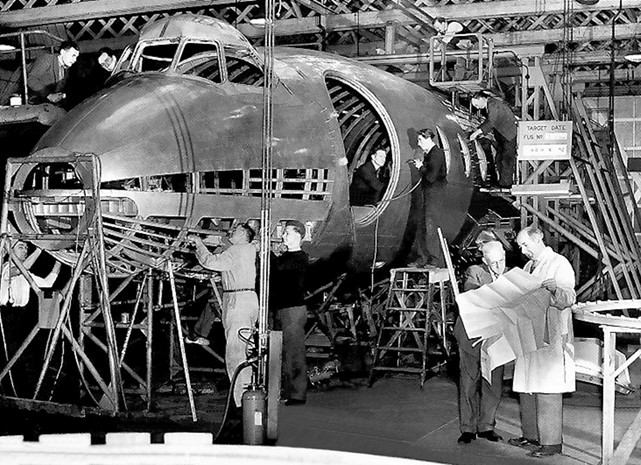
Viscount c/n 13 G-AMOC under construction in 1952
The airframe structure followed the normal pattern of a stressed skin, single-spar wing with a fuselage based
on unbroken hoop frames. However, the need for pressurisation presented new problems and variations from the
optimum cylindrical cross section had to be made to cater for stresses set up in cut-outs made for the doors
and windows. Large elliptical windows provided the strongest structure and gave passengers an excellent view.
Good directional stability was provided by a high-angled dihedral on the horizontal tail plane.
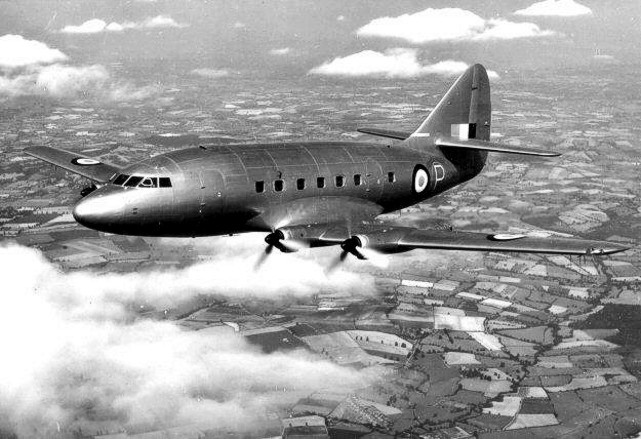
Armstrong Whitworth Apollo
As for the power plant, Edwards favoured the 1,130ehp (841kW) Rolls-Royce Dart, RDa1, which had a centrifugal
compressor, believing that this would give the best service life and reliability over the alternative, axial
compressor of the Armstrong Siddeley Mamba. As things turned out, he was right, for as an insurance against
the VC2 project failing, the Ministry of Supply (MoS) ordered two Armstrong Whitworth Apollo prototypes,
powered by the Mamba. Although the prototypes flew, this aircraft was not pursued to production, due to the
engine’s unreliability at the time.
In April 1946, the MoS issued Specification 8/46 to cover the Type IIB airliner concept, and a contract for two
prototypes was awarded to Vickers on the understanding that it would finance a third itself. The requirements
called for a payload of 7,500lbs (3,410kgs) and capacity of 275cu ft (25.6 cu m), with a gross weight of
38,000lbs (17,270 kgs), which required a longer fuselage and greater wingspan than that originally proposed.
Based on this specification, operating costs were estimated at 6 old pence (2.5p) per ton mile, with a 3,000
hour annual utilisation factor.
As the newly-formed BEA - British European Airways, was expected to be the first recipient of the VC2, its
development - and indeed, the 8/46 specification - had been pursued in close co-operation with this operator.
But there was much post war underestimation of passenger capacity by the civil aviation industry and, as will
be seen, the Viscount had to be stretched more than once to cope with increased demand.
In to Production
Work began at Weybridge, Surrey under the Vickers type number V.609 in 1946, but by August 1947, Rolls-Royce had
already increased the power of the original engine to 1,250 ehp (931kW), and it had become known as the RDa4.
The improved engines were fitted to the first prototype, G-AHRF under type number V.630, and around this time
the aircraft was officially named the Viscount. It had been intended to call it the Viceroy, but because India
had just become independent, the office of 'Viceroy' no longer existed.
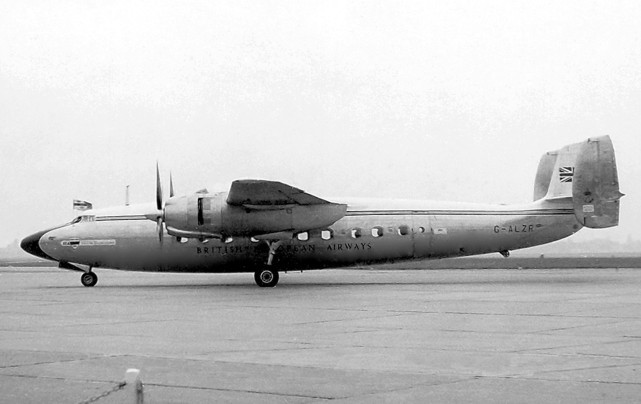
Airspeed Ambassador G-ALZR
However, a serious setback occurred after BEA began to have doubts about the economics of operating the
Viscount. Its calculations indicated that the aircraft needed to be bigger, and furthermore, under government
pressure, the corporation ordered 20 Ambassadors, carrying at least 40 passengers. For some months, the Viscount
project stalled, while Vickers looked at ways in which it might increase the passenger carrying capability.
Fortunately, Edwards, supported by Vickers' Managing Director, Sir Hew Kilner, fought to keep up the momentum.
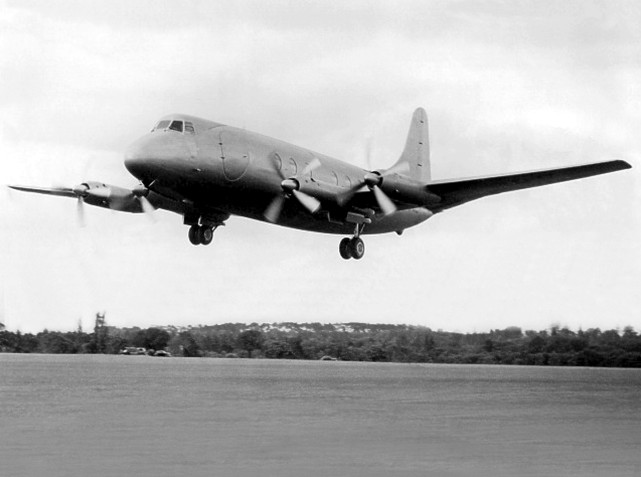
Prototype Viscount c/n 1 G-AHRF on its maiden flight 16 July 1946
With the first prototype completed by 1948, ‘Mutt’ Summers, the company's Chief Test Pilot, took G-AHRF on its
maiden flight from Wisely Airfield in Surrey on July 16. Flight trials demonstrated its excellent performance
and the smooth operation of the Dart turboprops. In the meantime, the Ambassador was delayed because of
structural problems. Fortuitously, Rolls-Royce was also able to offer Vickers more power via its 1,250ehp
(931kW) RDa4, Mk503, which now made a stretched version of the Viscount a practical proposition.
Type V.700
As a result, the type V.630 was put on hold and the type V.700 Viscount emerged, with a wingspan increased by a
further 5ft 6in (1.7m) and a fuselage lengthened by 7ft 6in (2.3m). It had a gross weight of 45,000lbs
(20,454kgs) and could accommodate 43 passengers, and the improved engine increased the cruising speed to 335mph
(540kph). The MoS ordered one prototype in February 1949, covered by Specification 21/49, and this aircraft,
G-AMAV, flew in August 1950.
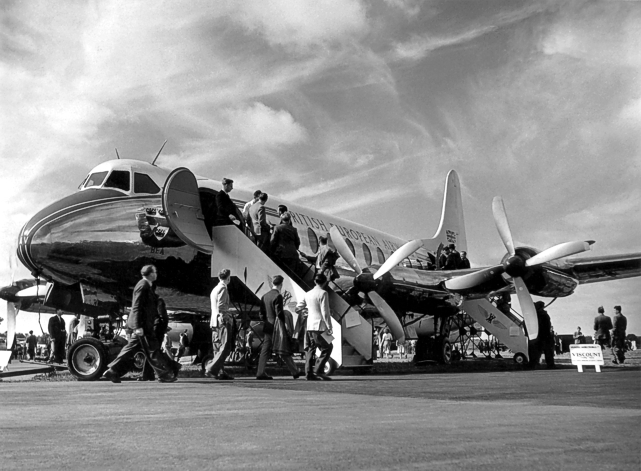
V.700 prototype Viscount c/n 3 G-AMAV at the Farnborough Air Show
Having achieved the mandatory 15-hour flying time, the type V.700 was flown at the Farnborough Air Show the
following month, where the silky whine of the Dart engines attracted much attention. The large oval windows
were then also unique to the industry. Later the operational gross weight was later increased to 57,000lbs
(25,909kgs), with a capacity for 53 passengers. But pre-empting this performance, BEA had already operated the
world’s first scheduled, turboprop passenger service with the prototype G-AHRF. Under a special Certificate of
Airworthiness (CofA), it flew from London/Northolt to Paris on July 29, 1950, piloted by Captain Dick Rymer,
with a compliment of specially-selected passengers. BEA continued these flights for two weeks and then went on
to make eight trips to Edinburgh for the annual summer festival.
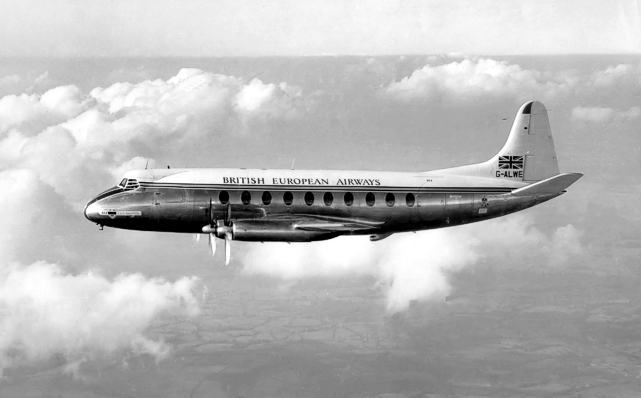
The first BEA Viscount G-ALWE was delivered in January 1953
The airline was delighted with the performance of the type V.700 prototype, which confirmed the conviction of
its Chief Executive, Peter Masefield, that the Viscount was the right aircraft at the right time. It placed an
order for 20 type V.700’s (later increased to 26) and the first production example, G-ALWE, flew in August 1952.
Deliveries began in January 1953, and a CofA for the type was granted on April 17. The following day, a
scheduled service from London to Nicosia, via Rome and Athens, was inaugurated. The BEA aircraft were initially
fitted with the 1,400SHP RDa3 Mk505 that were gradually upgraded to the Mk506 standard which improved the
aerodynamic flow through the compressor and turbine, reducing fuel consumption.
BEA also used the prototype V.700 to compete in the England to New Zealand Air Race. It flew at a gross weight
of 65,000lbs (29,545kg), covering the 12,000-mile (19,354km) route in 40hr, 45mins. One non-stop stage of 3,530
miles (5,694km) was at an average speed of 343mph (553kph).
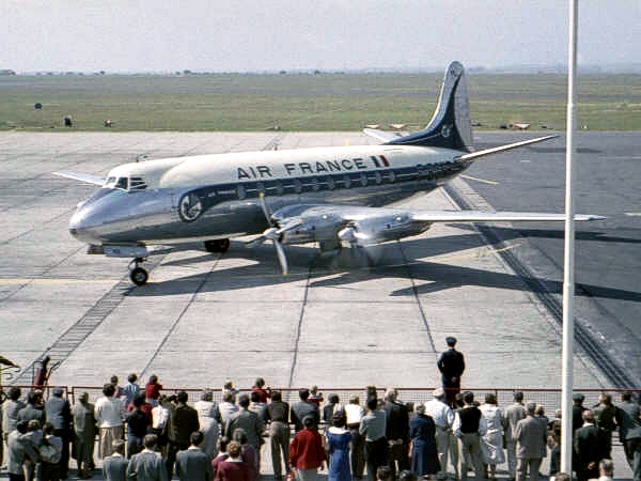
Air France ordered 12 Viscounts
By the end of 1951, orders for the Viscount from overseas airlines had started to come in, Air France and Aer
Lingus ordering respectively, twelve and four, aircraft. The following June, TAA - Trans Australia Airlines
purchased six, enabling the company to fly the 1,300-mile (2,096km) route from Adelaide to Perth, non-stop. A
notable breakthrough also came in November 1952, when TCA - Trans-Canada Air Lines (now Air Canada) placed an
order for 15. This requirement involved considerable re-design to meet North American regulations, including a
two-pilot crew and automatic flight control systems.
In February 1953, the prototype type V.700 achieved another first for a turboprop airliner when it flew across
the Atlantic by the northern route to carry out Canadian cold weather trials.
Type V.800 to V.806
Meanwhile, Rolls-Royce continued to enhance the capabilities of the Dart, and BEA, excited by the prospect of
more power, asked Vickers to build a Viscount, 13ft (4m) longer, which could take 86 passengers. In the event,
this variant was not built as Vickers found that it could achieve almost the same result by moving back the
rear bulkhead of the V.700 by 9ft 3in (2.84m) and extending the outer fuselage by 3ft 10in (1.2m), thus
providing accommodation for up to 65 passengers. This design became the type V.800, initially powered by the
1,535 ehp (1,143kW), Dart RDa6 and BEA ordered twelve examples in April 1954.
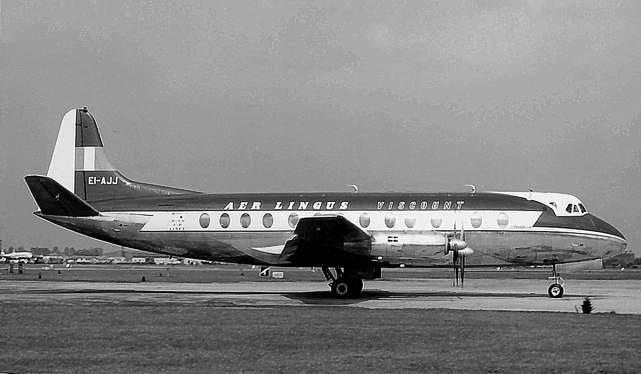
Aer Lingus was one of many operators who ordered the V.800 series
A notable innovation for the V.800 series was large rectangular access doors in place of oval doors, giving the
option of transporting freight. Many type V.700 Viscounts were upgraded with RDa6 engines and designated
Viscount V.700Ds, distinguished by having engine cowlings with a pronounced bulge. Other orders of note in 1953
included Hunting Clan, BWIA - British West Indian Airways, Iraqi Airways and the Indian Air Force while TCA
came back for five more type V.700s with the RDa6 engines. As orders built up, Vickers needed more production
capacity and opened another line at its Bournemouth/Hurn factory in Dorset.

Capital Airlines ordered 60 V.700s
In 1954, KLM of Holland ordered nine type V.800s - an unusual occurrence as the airline normally preferred
US-built aircraft. But the most significant trial order that year came from the American airline Capital, which
took three of the original type V.700s and followed this in August with a requirement for 37, V.700Ds, plus a
further 20 in December. In fact, Capital staked its whole operation on the Viscount, ordering 60 aircraft in all
(although the last 15 eventually went elsewhere), representing a British export order valued at $67 million.
Several modifications, in addition to those made for Canada, were necessary in order to obtain Federal Aviation
Administration (FAA) approval in the US.
The US airline industry was stunned by the Capital orders - not least Consolidated Vultee, which manufactured
the Convair CV-340, considered the Viscount’s main competitor in North America. American Airlines quickly
introduced the Douglas DC-6 to try to match the Viscount’s speed, but the British type continued to gain in
popularity. A lucrative Viscount transatlantic ferry market developed, in which freight was carried to and from
Prestwick via Iceland, Greenland and Goose Bay – quite an achievement for a short to medium-range aircraft.
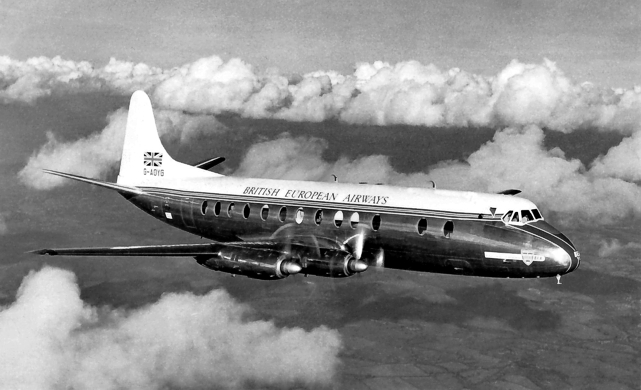
The BEA V.806 had the updated Rolls-Royce Dart RDa7
In 1956, a new, three-stage turbine Dart engine was introduced by Rolls-Royce as the RDa7. Mark 520, producing
1,630 SHP (1,210kW). BEA had just ordered a further 19 of the type for its fleet and decided to use the new
engine for these. Designated as the type V.806, it was to feature a 58-seat interior.
Ironically, the fleet was later converted to the RDa6 Mark 510 engine producing 1535 SHP as the RDa7 engines
were returned to Rolls-Royce for conversion to Mark 526 standard for use in the new BEA Armstrong Whitworth Argosy.
Type V.807 onwards
Vickers had been aware for some time that a Viscount which could fly faster, over greater distances, and with
more weight, was highly desirable. By 1957, Rolls-Royce had again increased the power of the Dart, this time by
modifying the RDa7 to produce 1,730 SHP, as the RDa7/1, Mark 525. Major structural changes were necessary for the
proposed variant, to cope with greater speeds and loads.
Further improvements resulted in the RDa7 Mark 530 producing 1,835 SHP. An RDa10 Mark 543 variant was proposed,
producing 2,305 SHP but the Rolls-Royce Tyne and the Vickers Vanguard took over before it was developed any
further. Both NAC in New Zealand and Aer Lingus in Ireland selected the earlier RDa6 Mark 510 engine for their
V.807 and V.808 aircraft which continued to be a viable option for other airlines as well.
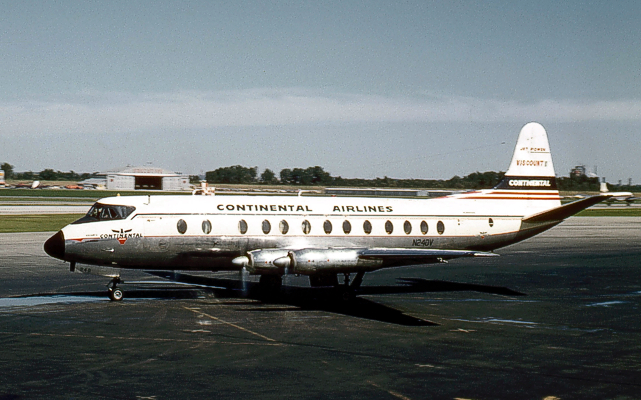
Continental Airlines ordered 15 V.812s
Continental Airlines of Denver, Colorado, had been much impressed by the projected performance of such an
aircraft and had already taken out an option for 15, should Vickers be successful. Deliveries to Continental
began shortly after FAA type certification for the V.810 in April 1958. The new variant could handle a gross
weight of 67,000lbs (30,454kgs) at take-off, with a payload of 15,000lbs (6,818kgs), and maintain a cruise speed
of 365mph (588kph). Continental’s order was followed by nine other national airlines and many independents, and
final production totalled 84.
By 1958, Vickers’ orders for the Viscount had reached 400, of which 300 had already been delivered. BEA’s fleet
alone stood at 77, and with load factors consistently at 80%, the airline was showing excellent profits. By the
time Vickers ceased production of the type in 1964, a total of 444 had been sold to 50 major airlines, with a
value, including spares, of £177 million, export sales accounting for £147 million. The final Viscount
delivered was to CAAC, the national carrier of The People’s Republic of China.
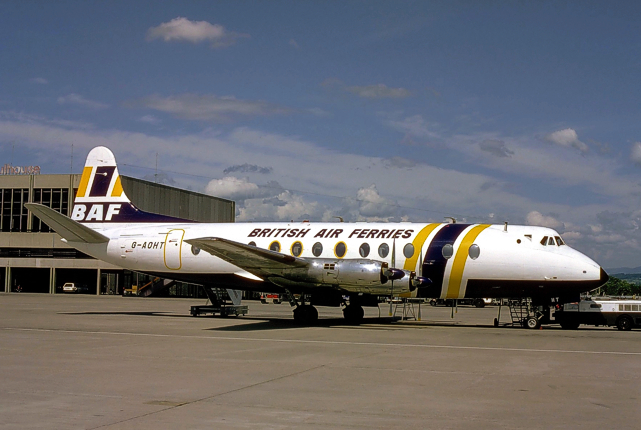
BAF - British Air Ferries was the largest UK operator of retired Viscounts
When second-hand aircraft became available, they were immediately snapped up by other airlines, independents
and corporate customers. Channel Airways, for example, took eleven of Continental’s type V.810’s and operated
them until 1972. BAF - British Air Ferries, the largest UK operator of retired Viscounts, introduced a life
extension modification programme in 1980 for up to 17 aircraft and leased them out for passenger and freight
work until 1998. Many others were still flying overseas for charter and freight until the late 1990s. According
to the 2007 edition of Survivors (A survey of surviving classic transport aircraft by Roy Blewett,
published by the Gatwick Aviation Society) a total of 47 Viscount airframes survive worldwide. Of these, 15 are
preserved in various museums. Five are in England, including type V.806, G-APIM, which is on display
at the Brooklands Museum, Weybridge, where construction began in 1946.
This article by Gerry Sweet was also published in the July 2008 issue of Airliner World.
 Airliner World
Airliner World
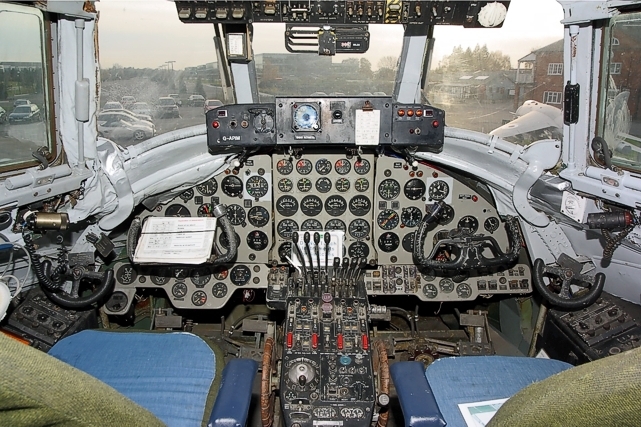
All the dials from the four turboprop engines make the cockpit a little cluttered
 History and photos of the prototype Viscount G-AHRF
History and photos of the prototype Viscount G-AHRF



